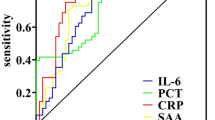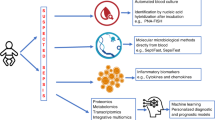Abstract
Objectives:
To evaluate the accuracy of serum amyloid A (SAA), an acute phase protein in the detection of neonatal early-onset sepsis, by means of a fast automated SAA kit.
Study Design:
Full-term infants <72 h of age, who had risk factors and/or were suspected of having sepsis, were eligible for study. The levels of SAA were taken at 0, 24 and 48 h post sepsis evaluation. Thirty matched infants served as a control group for comparing SAA concentrations.
Results:
Of 104 infants eligible for entry to the study, 23 had sepsis and 81 had not sepsis. The SAA levels of the septic group were significantly higher than those of the nonseptic group at 0, 24 and 48 h (P<0.01 for all time points). In comparison with C-reactive protein (CRP), SAA levels rose earlier and in a sharper manner, had higher levels and returned faster to normal values in infants with early onset sepsis. At 0 h post-sepsis evaluation, serum SAA had an overall better diagnostic accuracy for predicting early onset sepsis than CRP (sensitivity (96 vs 30%), specificity (95 vs 98%), positive predictive value (85 vs 78%), negative predictive value (99 vs 83%), positive likelihood ratio (19 vs 12), and negative likelihood ratio (0.05 vs 0.71).
Conclusions:
SSA is advocated as an inflammatory marker of neonatal early-onset sepsis.
This is a preview of subscription content, access via your institution
Access options
Subscribe to this journal
Receive 12 print issues and online access
$259.00 per year
only $21.58 per issue
Buy this article
- Purchase on Springer Link
- Instant access to full article PDF
Prices may be subject to local taxes which are calculated during checkout

Similar content being viewed by others
References
Gerdes JS . Diagnosis and management of bacterial infections in the neonate. Pediatr Clin North Am 2004; 51: 939–959.
Remington JS, Klein JO . Current concepts of infections of the fetus and newborn infant In: Remington JS, Klein JO (eds). Infectious Diseases of the Fetus and Newborn Infants. 4th edn. WB Saunders: Philadelphia, 1995; 1–19.
Volante E, Moretti S, Pisani F, Bevilacqua G . Early diagnosis of bacterial infection in the neonate. J Matern Fetal Neonatal Med 2004; 16: 13–16.
van Rossum AM, Wulkan RW, Oudesluys-Murphy AM . Procalcitonin as an early marker of infection in neonates and children. Lancet Infect Dis. 2004 Oct 4: 620–630.
Orlikowsky TW, Neunhoeffer F, Goelz R, Eichner M, Henkel C, Zwirner M et al. Evaluation of IL-8-concentrations in plasma and lysed EDTA-blood in healthy neonates and those with suspected early onset bacterial infection. Pediatr Res 2004; 56: 804–809.
Ng PC, Li G, Chui KM, Chu WC, Li K, Wong RP et al. Neutrophil CD64 is a sensitive diagnostic marker for early-onset neonatal infection. Pediatr Res 2004; 56: 796–803.
Malle E, De Beer FC . Human serum amyloid A (SAA) protein: a prominent acute-phase reactant for clinical practice. Eur J Clin Invest 1996; 26: 427–435.
Mozes G, Friedman N, Shainkin-Kestenbaum R . Serum amyloid A: an extremely sensitive marker for intensity of tissue damage in trauma patients and indicator of acute response in various diseases. J Trauma 1989; 29: 71–74.
Liberatori S, Bini L, De Felice C, Magi B, Marzocchi B, Raggiaschi R et al. Acute-phase proteins in perinatal human plasma. Electrophoresis 1997; 18: 520–526.
Arnon S, Litmanovitz I, Regev R, Lis M, Shainkin-Kestenbaum R, Dolfin T . Serum amyloid A protein in the early detection of late-onset bacterial sepsis in preterm infants. J Perinat Med 2002; 30: 329–332.
Arnon S, Litmanovitz I, Regev R, Bauer S, Lis M, Shainkin-Kestenbaum R et al. Serum amyloid A protein is a useful inflammatory marker during late-onset sepsis in preterm infants. Biol Neonate 2005; 87: 105–110.
Arnon S, Litmanovitz I, Regev R, Lis M, Shainkin-Kestenbaum R, Dolfin T . The prognostic virtue of inflammatory markers during late-onset sepsis in preterm infants. J Perinat Med 2004; 32: 176–180.
Haque KN . Definitions of bloodstream infection in the newborn. Pediatr Crit Care Med. 2005; 6: 45–49.
Wada A, Yamada T, Itoh Y, Itoh K . Sensitive enzyme-linked immunosorbent assay for human serum amyloid A (SAA) and application to clearance study [English summary, article in Japanese]. Rinsho Byori 1998; 46: 1252–1257.
Franz AR, Bauer K, Schalk A, Garland SM, Bowman ED, Rex K et al. Measurement of interleukin 8 in combination with C-reactive protein reduced unnecessary antibiotic therapy in newborn infants: a multicenter, randomized, controlled trial. Pediatrics 2004; 114: 1–8.
Casl MT, Bulatovic G, Orlic P, Sabljar-Matovinovic M . The diagnostic capacity of serum amyloid A protein for early recognition of kidney allograft rejection. Nephrol Dial Transplant 1995; 10: 1901–1904.
Nakayama T, Sonoda S, Urano T, Yamada T, Okada M . Monitoring both serum amyloid A protein and C-reactive protein as inflammatory markers in infectious diseases. Clin Chem 1993; 39: 293–297.
Shainkin-Kestenbaum R, Winikoff Y, Cristal N . Serum amyloid A levels during the course of acute ischemic heart disease. J Clin Pathol 1986; 49: 635–637.
de Villiers WJ, Louw JP, Strachan AF, Etsebeth SM, Shephard EG, de Beer FC . C-reactive protein and serum amyloid A protein in pregnancy and labour. Br J Obstet Gynaecol 1990; 97: 725–730.
Marchini G, Berggren V, Djilali-Merzoug R, Hansson LO . The birth process initiates an acute phase reaction in the fetus-newborn infant. Acta Paediatr 2000; 89: 1082–1086.
Maury CPJ . Comparative study of serum amyloid A protein and C-reactive protein in disease. Clin Sci 1985; 68: 233–238.
Badolato R, Wang JM, Stornello SL, Ponzi AN, Duse M, Musso T . Serum amyloid A is an activator of PMN antimicrobial functions: induction of degranulation, phagocytosis, and enhancement of anti-Candida activity. J Leukoc Biol 2000; 67: 381–386.
Acknowledgements
We wish to thank Dr T Yamada, Department of Clinical Pathology, Juntendo University, School of Medicine, Tokyo, Japan, who kindly provided the serum Amyloid A kit and Ilana Gelernter, MA, the Statistical Laboratory of the School of Mathematics, Raymond and Beverly Sackler Faculty of Exact Sciences, Tel Aviv University, Tel Aviv, for statistical consultation.
Author information
Authors and Affiliations
Corresponding author
Rights and permissions
About this article
Cite this article
Arnon, S., Litmanovitz, I., Regev, R. et al. Serum amyloid A: an early and accurate marker of neonatal early-onset sepsis. J Perinatol 27, 297–302 (2007). https://doi.org/10.1038/sj.jp.7211682
Received:
Revised:
Accepted:
Published:
Issue Date:
DOI: https://doi.org/10.1038/sj.jp.7211682
Keywords
This article is cited by
-
Point-of-Care Serum Amyloid A as a Diagnostic Marker for Neonatal Sepsis
Indian Journal of Pediatrics (2023)
-
Knowledge gaps in late-onset neonatal sepsis in preterm neonates: a roadmap for future research
Pediatric Research (2022)
-
Biomarkers of sepsis: time for a reappraisal
Critical Care (2020)
-
Prognostic value of serum amyloid A in patients with COVID-19
Infection (2020)
-
Anti-microbial stewardship: antibiotic use in well-appearing term neonates born to mothers with chorioamnionitis
Journal of Perinatology (2017)



